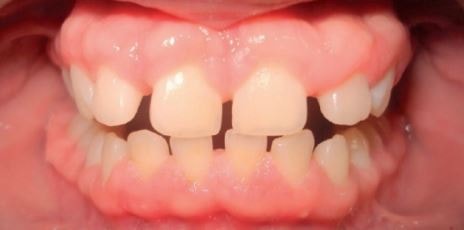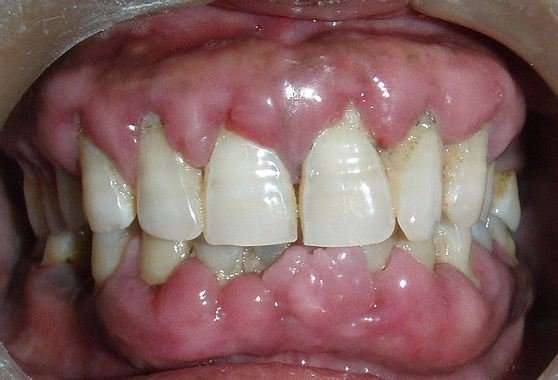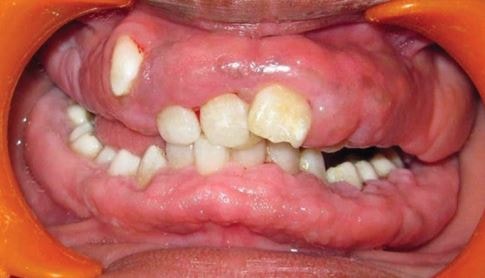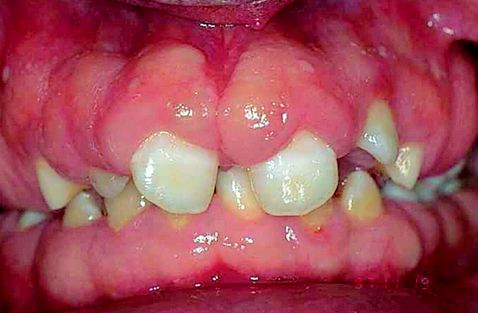Gingival Hyperplasia
What is Gingival Hyperplasia?
Gingival Hyperplasia is the condition where the gums enlarge or increase in size due to an increase in the number of cells (hyperplasia). This could be a manifestation a gum disease, a side effect of a medication or a sign of an underlying pathology.

Gingival hyperplasia is a term that is strictly used to describe the morphology and characteristic of the gum tissues, inflammation or enlargement of the gums must not be automatically termed as gingival hyperplasia. Such term would only be used if a microscopic study of the gum tissue is done, and if indeed the gum tissues are seen to increase in number. The more recent and accepted term is gingival enlargement.
Gingival Hyperplasia in Dogs
Dogs may also have this same condition in humans. It is more common among Boxer dogs or the so called brachycephalic dog breeds. These dog breeds have skulls that are broad and short.
Dogs that belong to the brachycephalic breed include:
- American Bulldog
- Boxer
- Boston Terrier
- Bullmastiff
- Bulldog
- Cane Corso
- Cavalier King Charles Spaniel
- French Bulldog
- Pug
- Rottweiler
- Shih-Tzu
- Shar-Pei
- Chow Chow
- Tibetan Spaniel
Gingival hyperplasia in dogs usually begin at their middle age and progresses thereafter. The hyperplasia can begin largely in one area and can completely cover the whole teeth. This condition among dogs is usually a sign of inflammation and infection and this could be managed surgically but still has the tendency to recur. This condition may also lead to gingivitis or can also be an effect of ciclosporin use.
Gingival Hyperplasia In Cats
The same condition can also affect cats. Gingival hyperplasia in cats may be a result of poor hygiene (as in most cases), drug side effect or a sign of an underlying condition. if gingival hyperplasia is present, a veterinarian must carefully assess ii to rule out the possibility of malignancies or any other conditions. Treating the condition early is very important so to prevent periodontal diseases.
Gingival Hyperplasia Diagnosis in Dogs and Cats
Clinical Inspection
A veterinarian would inspect the mouth and note for the characteristics of the gums. A normal healthy gum must be pinkish in color, and its size does not cover nor occlude the teeth. Signs that the dog or cat has gingival hyperplasia include:
- Redness of the gums
- Inflammation,
- Presence of a gum overgrowth
- Tooth/teeth covered completely or partially by the gums.
Biopsy
A small sample of the gum tissue is sliced and placed under the microscope for histologic studies. The histologic studies would show the characteristics of the gum tissue if it is indeed hyperplasic (in the case of gingival hyperplasia), hypertrophic or neoplastic (in the case of cancer). This helps the veterinarian rule out any other disease conditions.
Causes
Chronic Inflammation
Chronic inflammation brings a myriad of changes in the cellular make-up of the gums. Constant inflammation causes edema and infiltration in the tissues; this in turn can cause the cells to become hyperplasic. Chronic inflammation is attributed to long term bacterial exposure. The toxins and other harmful chemicals released by these bacteria causes changes in the gum tissue.
Drug Side Effects
Gingival Hyperplasia is also seen as a side effect of the following drug classes:
Cyclosporines- This is an immunosuppressant drug
Calcium Channel Blockers- these are medications used to control high blood pressure.
- Amlodipine
- Verapamil
- Nifedipine
Anticonvulsants- drugs used to prevent or control seizure attacks
- Phenobarbital
- Lamotrigine
- Valproate
- Ethosuximide
- Topiramate
- Primidone
- Phenytoin
- Vigabatrin
Systemic Factors
Other disease conditions or systemic physiologic changes is also seen to cause gingival hyperplasia
Vitamin C deficiency
Vitamin C helps maintain a healthy skin and mucus membrane. This vitamin is an important factor in collagen formation, a substance essential in maintaining tissue integrity and facilitates tissue repair. Gingival hyperplasia as a result of Vitamin C deficiency can be due to the lack of tissue integrity and cell repair in the gums.
Pregnancy
Gingival hyperplasia can also be seen as a result of pregnancy. This is a normal reaction of the body to the increase in metabolic demand from the mother and the growing fetus. Hyperplasia may occur is compensation from the physiologic change.
Puberty
It can be result from hormonal activity and sudden increase in metabolic demand and cellular production as seen during the pubertal stage.
Benign Tumors
Benign growths such as papillomas, giant cell granulomas and fibromas are systemic disease conditions that can cause gingival hyperplasia. Benign tumors are non-cancerous tumors
Neoplasms or malignancies
Gingival hyperplasia can also be a manifestation of carcinoma or a malignant melanoma. The hyperplasia or increase in cellular number can also signify a ,malignant formation in the mouth, or elsewhere in the body.
Symptoms and Signs
- Gum Enlargement or Swelling
- Tenderness in the Gums
- Redness
- Bleeding especially when brushing
- Presence of plaques along the gum lines
- Presence of infection
- Discomfort or Difficulty while opening the mouth
- Outgrowth or a tumor in the gums
- Gums covering the tooth/teeth completely or partially
- Once these signs and symptoms are seen, one must seek immediate medical attention. Prompt visit to the physician allows early diagnosis and treatment of the condition. Severe cases of gingival hyperplasia can affect a person’s ability to take in food, preventing the condition from escalating this far is very essential.
Treatment
Drugs – Roxithromycin and Azithromycin
Clinical observations have shown that roxithromycin can reduce gingival hyperplasia caused by cyclosporine intake. Roxithromycine is an antibiotic, and is said to inhibit the production of beta-transforming growth factor, a compound seen to contribute on gingival hyperplasia. Another antibiotic, Azythromycin is also seen to reduce gingival hyperplasia. Although clinical studies suggest the use of this drug must be coupled with oral hygiene to become more effective.
Oral Hygiene with Chlorhexidine gluconate
Chlorhexidine gluconate has antiseptic and bactericidal properties. Such properties acts against bacteria that further worsen gingival hyperplasia. This is also preventing the patient from acquiring periodontal diseases which may occur with gingival hyperplasia.
Diet Therapy
Although not entirely a direct treatment for gingival hyperplasia, following a diet of minimal simple carbohydrates, starch, sweets, and carbonated drinks helps manage gingival hyperplasia.
Surgery
Gingivectomy or removal of the overgrowth is done for patients with moderate to severe gingival hyperplasia. This is done with YAG laser or with Carbon Dioxide. Surgical interventions is reserved for patients who do not respond to the conventional treatments.

Pictures



